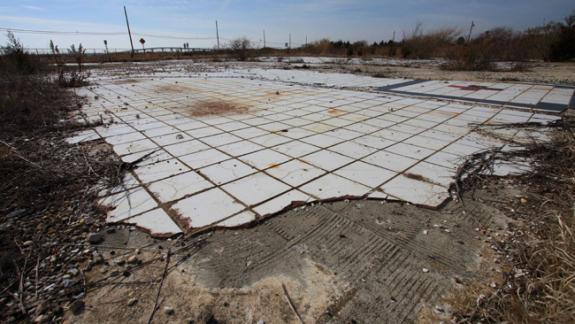Malibu Beach Maritime Forest Restoration Project
Conserve Wildlife Foundation of NJ is proposing to restore a section of the Malibu Beach Wildlife Management Area (WMA). The property is owned by the State of New Jersey, and managed by the NJ Division of Fish and Wildlife. The WMA is 95.7 acres total and is located in Egg Harbor Township, Atlantic County, between Longport, Somers Point, and Ocean City. The Conserve Wildlife Foundation of NJ seeks to carry out this proposed restoration project illustrated below.
 Tile floors mark the area where an old bar and tavern once existed on site. We have proposed to restore this small area to create migratory bird stopover habitat. © Ben Wurst
Tile floors mark the area where an old bar and tavern once existed on site. We have proposed to restore this small area to create migratory bird stopover habitat. © Ben Wurst
The habitat in the “triangle” at Malibu Beach Wildlife Management Area currently has little to no value to many species of wildlife, especially migratory songbirds. Adjacent beaches are critical feeding and resting areas for migratory, breeding, and wintering shorebirds. Currently, the New Jersey Department of Transportation is restoring portions of the beach by removing invasive species and establishing native species to provide habitat for wildlife. The upland “triangle” portion has been proposed for use as a dredge disposal site, which would have no value to wildlife. Studies have shown that migratory songbirds rely on coastal maritime forests for food and cover during fall migration. However, like most other areas along the entire east coast of New Jersey, the remaining forests on barrier islands are severely degraded. The need for more “islands” of maritime forest along the Atlantic Coast is crucial to protect the high numbers of songbirds that migrate along the coast of New Jersey each year.
 Zoom+ Site map of proposed habitat restoration inside Malibu Beach WMA. © CWF
Zoom+ Site map of proposed habitat restoration inside Malibu Beach WMA. © CWF
The proposed project will restore approximately 6 acres to native coastal forested habitat. A survey of the proposed restoration area will determine the site boundaries and characteristics. The removal of most undesirable vegetation will occur, while native species will remain in place. Soil samples and borings will be required to determine the soil characteristics and the soil will be restored with natural soils common to Atlantic coastal areas. The radio tower and trailer were recently removed. The Conserve Wildlife Foundation of NJ proposes to remove the chain link fence, concrete, and all other debris. The site will then be graded to mimic coastal topography.
Finally, a selection of native trees and shrubs will be planted at the site and include: Eastern Red Cedar (Juniperus virginiana), Pitch Pine (Pinus rigida), Common Juniper (Juniperus communis), Beach Plum (Prunus maritime), Winged Sumac (Rhus copallina), American Holly (Ilex opaca), Black Cherry (Prunus serotina), Sassafras (Sassafras albidum), Northern Bayberry (Myrica pensylvanica), Shadblow Serviceberry (Amelanchier candensis), Virginia Creeper (Parthenocissus quinquefolia), and Rugosa Rose (Rosa rugosa). A requirement of planting will be the continued watering of the area for up to 1 year to provide the vegetation to establish an adequate root system. This requirement will foster a healthy transition back to native species and will ensure the success of this project.
Budget:
- Removal of fill and micro topographic grading - $30,000
- Invasive Species Control (Mechanical removal and/or herbicide treatment - $6,000
- Trees/shrubs and planting @ $2,600/acre x 4.5 acres - $11,700
- Professional services (i.e. site surveys, permits, design) – $20,000
- Administrative costs - $20,000
- Total project cost - $87,700
Post restoration monitoring:
Survey scrub shrub/forest each summer for 3 years for the occurrence of any invasive species and treat as necessary for removal by use of hand applied glycosphate herbicide (RoundUp). During spring/fall migration conduct migratory bird survey similar to the breeding bird survey, which is a broad-scale, multi-species survey with a stratified random road-side sampling scheme, in which data are collected mostly by volunteers.
Links:
- NJ Division of Fish and Wildlife - Malibu Beach WMA Map
- Project listing on The Conservation Exchange - NJ's Marketplace for Conservation Projects
References:
- Martin, W .E. 1959. The vegetation of Island Beach State Park, New Jersey. Ecol. Monogr., 29: 1-46.
- Morris, S.R., et. Al. 2003. Television tower mortality of migrant birds in western New York and Youngstown, Ohio. Northeastern Naturalist 10:67-76.
- Sutton, Patricia. New Jersey’s native trees, shrubs & vines that are beneficial to birds. 2008.
Find Related Info: Habitat Restoration







